John Carr (architect)
John Carr (1723–1807) was a prolific English architect, best known for Buxton Crescent in Derbyshire and Harewood House in West Yorkshire. Much of his work was in the Palladian style. In his day he was considered to be the leading architect in the north of England.[1]
John Carr | |
|---|---|
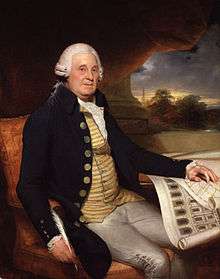 Portrait of John Carr by William Beechey, 1791 | |
| Born | 1723 |
| Died | 22 February 1807 (aged 83–84) |
| Nationality | English |
| Occupation | Architect |
| Buildings | Harewood House, Buxton Crescent, Constable Burton Hall, Tabley House, Basildon Park, Lytham Hall, Fairfax House |
Life
He was born in Horbury, near Wakefield, England, the eldest of nine children and the son of a master mason, under whom he trained.[2] He started an independent career in 1748 and continued until shortly before his death. John Carr was Lord Mayor of York in 1770 and 1785.[1] Towards the end of his life Carr purchased an estate at Askham Richard, near York, to which he retired. On 22 February 1807 he died at Askham Hall. He was buried in St Peter and St Leonard's Church, Horbury, which he had designed and paid for.[2]
Career
Carr decided to remain in Yorkshire rather than move to London because he calculated that there was ample patronage and the wealth to sustain it. No job was too small. His largest work, only partially finished, was the Hospital de Santo António in Oporto, Portugal. In order to maximise his income, he kept his staff to the minimum. His earliest assistant was William Lindley (architect 1739-1818),[3] who from 1774 developed an independent practice. He was followed by the elder Peter Atkinson (1735-1805)[4] and possibly his son Peter the younger (1780-1843). Carr's nephew William Carr also assisted his uncle in his latter years. These architectural assistants had 'boys' to help them in turn. Carr rarely delegated matters that others would regard as too trivial, and in consequence Carr had to travel immense distances mostly on horse back.[5] However the frequency of such visits brought him into regular contact with his many clients to mutual advantage.[6]
Carr’s own favourite work was the Crescent at Buxton in Derbyshire, an early example of multifunctional architecture. As well as hotels and lodging houses, it contained Assembly Rooms, shops, a post office and a public promenade all under one roof.[7] On a smaller scale, the same is true of his Newark Town Hall.[8]
Other public buildings included hospitals (e.g., Lincoln and York), racecourse grandstands (e.g. York, Doncaster and Nottingham), (all now demolished), and prisons at Wakefield and Northallerton. He designed new churches as well as repairing old ones. The former were all privately financed, the latter were financed by the existing parishes. His single span roof construction allowed him to build the new churches without the traditional subdivision into nave and aisles.[9]
He served as bridgemaster for both the North and West Ridings of Yorkshire, leaving a legacy of countless bridges the majority of which still stand today.[10] The more than 60 bridges built or altered by Carr still serve the backbone of North Yorkshire's road transport network. Carr was Lord Mayor of York in 1770 and 1785.
His commissions for country houses included model villages and farms, stable blocks, a variety of gate lodges and gateways, garden temples and other ornamental buildings. Notable among them his works for the estates of Harewood and Wentworth Woodhouse.[11]
He took particular care with their planning and construction to maximise value for money for both the immediate patron and for the buildings' future long-term maintenance. He used traditional materials and methods of construction where these had proved sound, but adopted new methods and materials where these could be shown to have an advantage. His training as a stonemason naturally led him to build in that material. In particular he enjoyed using 'great' stones as at Tabley House. He liked well proportioned rooms which were satisfactory living spaces with or without decorative enrichment. In his view the latter could be provided later if money permitted. As a result, most of his buildings were completed and because of the soundness of construction most survive.
Among the buildings accessible in whole or part to the public today are Buxton Crescent, Newark Town Hall, virtually all his bridges, Harewood House, Tabley House, Clifton House (a museum in Rotherham), Lytham Hall and Fairfax House at 27 Castlegate York, now the headquarters of York Civic Trust.
Influences
During his long career there were several major changes in architectural style. His early work is a mixture of the Palladian and the Rococo. He then sought a purer Antique Roman style with occasional French influences before adapting the currently fashionable style associated with Robert Adam. At the end of his life he returned to the bolder Palladian style of his youth but with detail that looked forward to 19th-century usage.
Carr's work was influenced by the books of Sebastiano Serlio and Andrea Palladio. He subscribed to many architectural pattern books, including those of his friend George Richardson, and also contemporary publications by Robert Morris and William Chambers.[2]
List of works
Public buildings
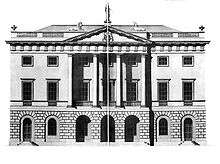
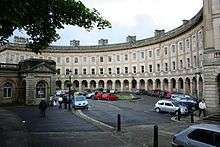
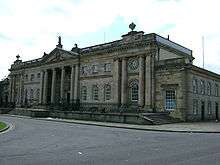
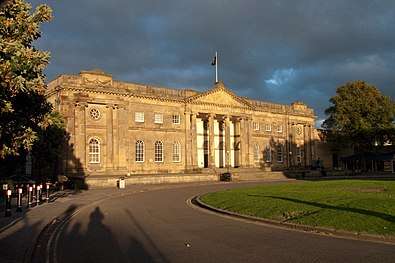
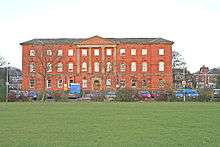
(dem = demolished) in chronological order, county given if not Yorkshire
- York The Pikeing Well-House New Walk 1752–56
- York Grandstand Knavesmire Racecourse 1755–56 dem
- Beverley Assembly Rooms, 1761–63 dem
- Wakefield, The House of Correction, 1766–70 dem
- Leeds, The General Infirmary, 1768–71 dem
- Oporto, Portugal, The Hospital de Santo António 1769-c. 1843
- Newark, Notts., Town Hall, Assembly Rooms and Market Hall, 1773–76
- York, Assize Courts, now York Crown Court 1773–77
- York County Lunatic Asylum, now Bootham Park Hospital 1774–77
- Lincoln, Lincs., Lincoln County Hospital 1776
- Doncaster, Racecourse Grandstand, 1777–81 dem
- Nottingham, racecourse grandstand, 1777 dem
- Nottingham, Notts., Assembly Rooms, 1778 dem
- Kelso, Roxburghs., design for Racecourse Grandstand, 1778 (built in 1822)
- Buxton, Derbys., The Assembly Rooms in the Crescent 1779–90
- York, The Female Prison, 1780–83
- Northallerton, Court House, 1784–88 dem
- Northallerton, House of Correction 1784–88[12]
- Chesterfield, Derbys., Town Hall, 1787–88 dem
- Lismore, Waterford, design for Session House, 1799
Churches
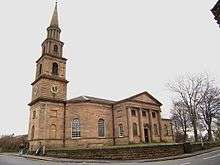
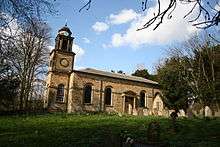
- Ravenfield, 1756;
- Kirkleatham, Payment for design, 1759;
- Dewsbury Minster, Partly rebuilt 1765-7;
- Bierley, 1766; attributed:
- Boynton, largely rebuilt 1768–70;
- York Minster, survey and repairs 1770-3 and 1794–97; Joseph Halfpenny was clerk of works on this project[13]
- Sheffield, St. Peter, alterations 1773-5;
- Rokeby, completed church 1777-8;
- Denton, 1776; attributed
- Holy Rood Church, Ossington, Notts., 1782-3;
- St Peter and St Leonard's Church, Horbury, 1790-4.
Bridges
North and East Ridings of Yorkshire
- Aysgarth (R.Ure), 1788;
- Ayton (R.Derwent), 1775;
- Bainbridge (Yore Bridge, River Ure, (1793) and Bain Bridge, River Bain, (widened 1785))
- Birdforth (Birdforth Beck) 1798dem;
- Bow Bridge, (R.Rye), 1789;
- Catterick (R.Swale) 1792;
- Crambeck 1785;
- Croft (R. Tees), 1795;
- Danby Wiske, 1782;
- Downholme, (R.Swale), 1773;
- East Row,Sandsend, nr. Whitby, 1777;
- Ellerbeck, nr. Osmotherley, 1790;
- Greta, nr.Rokeby, 1773;
- Grinton (R.Swale), 1797;
- Hawnby (R.Rye), 1800;
- Howsham Bridge not executed
- Kilvington (Spital Beck), 1774dem;
- Kirkham Bridge not executed
- Low Bourn (R.Burn), nr. Masham 1775;
- Morton on Swale (R.Swale), 1800-3;
- South Otterington (R.Wiske) 1776;
- Reeth (Arkle Beck), 1772-3;
- Riccall, nr. Helmsley, 1803;
- Richmond (R.Swale), 1789;
- Rutherford (R.Greta), 1773;
- Skeeby nr. Richmond, 1782;
- Skipton on Swale, 1783;
- Strensall, (R.Foss), 1798,
- Thirkleby, 1799;
- Thirsk Mill, Millgate, (over Cod Beck) 1789;
- York, Yearsley Bridge (R.Foss) 1794-5;
West Riding
- Carlton Ferry, nr. Snaith, (R.Aire)1774;
- Coniston Cold, (R.Aire), 1763;
- Ferrybridge, (R.Aire), 1797–1804) ;
- Marle Bridge (R.Dearne), nr. Darfield, 1766;
- Selby, 1795 in part for the wooden bridge at.
Private bridges
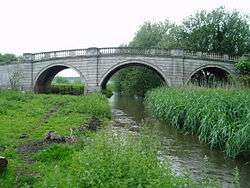
- Blyth, Notts., dated 1776, (now public);
- Denton Park, c. 1770;
- Harewood Park, Yorks. c. 1771;
- Norton Place Park, Lincs., c. 1776;
- Unexecuted bridge designs for Wentworth Woodhouse, Yorks.
Domestic architecture
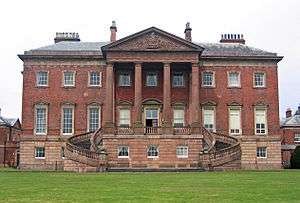
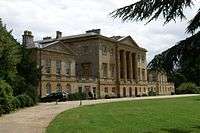
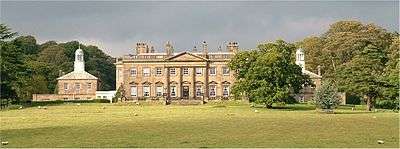
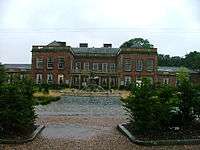
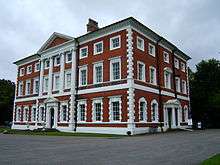
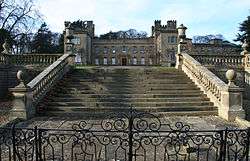
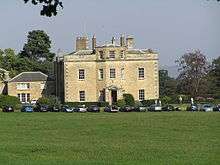
(The following are in Yorkshire, unless otherwise stated)
- The New Lodge, New Lodge, Barnsley (c.1760) – built as a dwelling for John Carr himself
- Kirby Hall, Ouseburn, 1747-c.55, dem.
- Huthwaite Hall, Thurgoland, 1748;
- Askham Hall, Askham Richard, Yorks., c. 1750 dem;
- Thorp Arch Hall, 1750-4;
- Gledhow Hall, Gledhow, Roundhay, Leeds c. 1764 for J. Dixon;
- Arncliffe Hall, Ingleby Arncliffe, c. 1750-4;
- York, No. 47, Bootham, 1752;
- Campsmount, Campsall near Doncaster, 1752-5 dem;
- Leeds, town house for J. Dixon 1753; Northallerton, 84 High Street, c.1754.
- Heath Hall, near Wakefield, 1754–80;
- York, Petergate, house for J. Mitchell, 1755 dem;
- York, Fairfax House, 27 Castlegate, circa 1755–62; Gilling Castle
- Howsham Mill, near Malton, c. 1755;
- Plompton Hall, near Knaresborough, c. 1755–62;
- York, Garforth House, No. 54 Micklegate, c. 1755-7;
- Lytham Hall, Lancs., 1757–64;
- Goldsborough Hall, remodelling, c. 1750s;
- Newby Hall, remodelling, c. 1758–60;
- Everingham Hall1758-64;
- Kirklees Hall, alterations, 1759–60;
- Harewood House, 1755–71; (except the decoration of the principal rooms)
- Harewood village and other estate buildings;
- Kirkland Hall, near Garstang, Lancs. 1760 ; attributed:
- Ravenfield Hall, near Rotherham, alterations, 1760–70 dem;
- Tabley House, Cheshire, c. 1760-7;
- Hornby Castle, c. 1760–70 partly dem;
- Wentworth Woodhouse, c. 1760- 1804,completed the house, and numerous important estate buildings.
- Clints Hall nr. Richmond, dem,
- Castlegate House, Castlegate, York 1762-3;
- Campsall Hall, alterations, 1762-4 dem;
- Stapleton Park, c. 1762-4 dem;
- Grove Hall, near Retford, Nottinghamshire remodelled c. 1762 dem;
- Constable Burton Hall, c. 1762-8;
- Escrick Park, remodelled, 1763-5;
- White Windows, Sowerby Bridge, 1763-8;
- Welbeck Abbey, Nottinghamshire 1763, 1774–7;
- Cannon Hall near Barnsley, 1764, 1778 onwards;
- Goldsborough Hall nr. Knaresborough, internal alterations, 1764-5;
- Swinton Park, nr. Masham, alterations 1764-7;
- Kirkleatham Hall, remodelling, 1764-7dem;
- Swarland Hall, near Felton, Northumberland, 1765 dem; attributed
- Courteenhall, Northamptonshire, stables, after 1765;
- York, Skeldergate, his own house, 1765-9 dem;
- Aske Hall, c. 1765-9;
- Boynton Hall near Bridlington, c.1765–80;
- Fangfoss Hall, East Yorkshire c.1766-;
- Halifax, Somerset House and warehouse, c. 1766;
- Towneley Hall, Lancashire, interiors, 1766-7,
- Pye Nest near Halifax, 1767dem;
- Thoresby Hall, Nottinghamshire. 1767–71 dem;
- Castle William, Budby Nottinghamshire, Thoresby Hall Estate c 1767
- Auckland Castle, Bishop Auckland, County Durham, alterations c.1767–72; attributed
- Raby Castle, County Durham, remodelled, 1768–88;
- Leeds, Bridge End, house for Mr. Green, before 1769;
- Kilnwick Hall, remodelled 1769–72, 1781 dem;
- The Shay, nr. Halifax, c. 1770dem;
- Byram Hall and farm, nr.Ferrybridge, remodelled c. 1770, largely dem;
- Gledstone Hall and stables nr. Skipton, c. 1770 house dem; attributed:
- Aston Rectory, near Rotherham, c. 1770;
- Somerby Hall, Somerby, Lincolnshire monument ashlar doric column topped by an urn for Edward Weston
- Sedbury Park, near Richmond, alterations c.1770 house dem;
- Denton Hall, Wharfedale, 1769–81;
- Chesters, near Hexham, Northumberland, 1771;
- Aston Hall near Rotherham, 1760s;
- Thirsk Hall, additions, 1771-3;
- London, Burlington House, Piccadilly, internal alterations, c. 1771-5dem;
- Ormesby Hall near Middlesbrough, stables and entrance lodge, c. 1772; attributed:
- Redbourne Hall, Lincolnshire, alterations, 1773;
- Blyth Hall, Nottinghamshire, 1773-6dem;
- Leventhorpe Hall, near Leeds,1774;
- Castle Howard, alterations and stables, 1774–82;
- Panton Hall, near Wragby, Lincolnshire, remodelling, 1775dem;
- Ribston Hall, near Knaresborough, alterations and stables, c. 1775; attributed
- Norton Place, Bishop Norton, Lincolnshire 1776;
- Billing Hall, Great Billing, Northamptonshire, 1776 dem;
- Basildon Park, Berkshire, 1776;
- Colwick Hall, Nottinghamshire, remodelled 1776;
- Middleton Lodge, Middleton Tyas, 1777–80;
- Sledmere, Castle Farm and designs for Sledmere House 1778;
- Clifton Hall, Notts. alterations, 1778–97;
- Staunton in the Vale Hall, Nottinghamshire, alterations 1778 -85;
- Bolling Hall, near Bradford, alterations 1779 -80;
- Thornes House, near Wakefield, designs for house, 1779-81dem;
- Langford Hall, Nottinghamshire c. 1780;
- Badsworth Hall, c. 1780dem;
- New Lodge, Wakefield Road, Barnsley, c. 1780;
- Wiganthorpe Hall, near Malton, c. 1780dem;
- Buxton, Derbyshire, The Crescent, St. Ann’s Well, and Great Stables. 1779–90;
- Grimston Garth, near Aldborough, 1781-6;
- Chatsworth House, Derbyshire, internal redecoration, c. 1782-4; (and for the same patron, the repair of Hardwick Hall).
- Clifton House, Rotherham,1783;
- Holker Hall, near Cartmel, Lancashire, minor works c. 1783, 1787;
- Workington Hall, Cumberland, extensive remodelling, 1783–91
- Belle Isle, Windermere, for the same patron. and minor changes to
- Cradside House Scotland.
- Sand Hutton Park, 1786dem;
- Eastwood House, Rotherham, 1786-7dem;
- Farnley Hall, near Otley, major extension, 1786–90;
- Castle William, Budby, Nottinghamshire, c. 1789;
- Durham Castle, remodelled gateway 1791;
- Bretton Hall, alterations, 1790s;
- Leck Hall, c.1790s
- Wood Hall, near Wetherby, c. 1795;
- Fawley Court, Buckinghamshire, lodges, 1797-9;
- Belle Vue (Claife Viewing Station) near Hawkshead, Lancashire, belvedere c. 1799;
- Coolattin Park (Malton House), Shillelagh, County Wicklow, Ireland 1800–1808;
- "Milton Hall, near Peterborough, Northamptonshire, internal alterations c. 1803 and orangery, 1788-9;
- Upleatham Hall, alterations, date uncertain;
- Tankersley Park, temple, date uncertain;
- Obelisk and monument: Knox’s Hill, Armagh, 1782-3;
- Bramham Park, after 1773; attributed:
- Wall monument, Otley All Saints, to Francis Fawkes of Farnley Hall, 1754, signed J Carr.
- Wall monument design for Buxton family (Goodchild Collection Wakefield)
- Wood Hall Yorkshire
- Chevet Hall, Wakefield (dem) and stable block
- Hook Moor Lodges, Great North Road A1 Aberford, West Yorkshire, part of the Parlington Hall Estate;
References
- John Carr (1723–1807), Wakefield Council, archived from the original on 28 May 2010, retrieved 16 July 2010
- "John Carr".
- H Colvin Yale Univ Press, p.654
- H Colvin Yale Univ Press p.76
- see correspondence Wentworth Woodhouse Muniments Sheffield Record Office
- Wentworth Woodhouse Muniments Sheffield Record Office
- see Carr's portrait (above) by Beechey where the building is illustrated
- York Georgian Society. (1973). The works in architecture of John Carr:a list prepared by the York Georgian Society.
- see plans in Wakefield County Record Office
- The Industrial Architecture of Yorkshire by Jane Hatcher, p. 69, ISBN 0-85033-527-2
- The relevant drawings are in the record offices of Leeds and Sheffield.
- Historic England. "Details from listed building database (1418378)". National Heritage List for England. Retrieved 30 July 2015.
- Stephen, Leslie; Lee, Sidney, eds. (1890). . Dictionary of National Biography. 24. London: Smith, Elder & Co.
Further reading
- Hall, Ivan (2013). John Carr of York A Pictorial Survey. Wakefield England: Rickaro Books. ISBN 9780954643959.
- Wragg, Brian (2000). Giles Worsley (ed.). The life and works of John Carr of York. York England: Oblong. ISBN 0-9536574-1-8.
External links
| Wikimedia Commons has media related to John Carr (architect). |